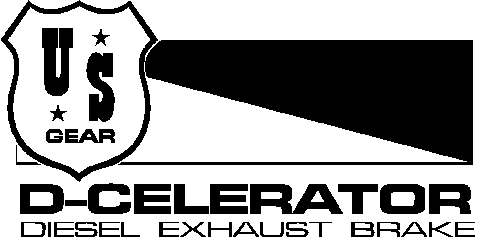D-Celerator Diesel Exhaust Brake Troubleshooting Guide
How the D-Celerator Works All U.S. Gear solenoid-actuated exhaust brakes operate on the same principle electronically. This includes Super Duty models (1st and 2nd design), Standard models (orifice-regulated), and 4" Super Duty electric models. D-Celerator units have an electric solenoid mounted to the cast housing. Three wires are attached to the solenoid using either a weatherproof connector, or with small screws through eyelets on tabs on the back of the solenoid housing. Each solenoid is equipped with two coils with differing functions. The gray wire in the harness is used to power up the first coil, called the `pull' coil. This requires about 55 amps at 12 volts to close the exhaust brake's butterfly valve. The second coil is the `hold' coil, and it usually operates at the same time as the pull coil. The hold coil requires much less amps, less than 2. The third wire is the ground connection (could be black or green). Most important, it needs a good clean connection to the frame of the truck, or other good ground on motor home applications. The second component is the Electronic Control Module (ECM). There are three different models of modules. They look different, but have the same method of operation. The first design of the ECM is a small, flat box about 3"x3"x1", generally mounted on or under the dash. It has a rocker on/off switch and three LEDs:
The second design of the ECM is similar in appearance to the first. It has a rocker on/off switch, and Green and Red LEDs. When the vehicle key is in the `run' position, the Green LED will illuminate. When the rocker switch is `on', both the Green and the Red LEDs will be illuminated. There is no wireless remote required, and there is no Yellow "shift down light." The second design also has the Cycle Feature at power up. With the cycle feature, the Green LED will blink at power up for approximately 15 seconds, then the butterfly valve will close and open two times. The third design of the ECM is a black box approximately 2"x2"x4" with seven wires and a pigtail attached, and should be mounted under the dash. This design uses a wired remote switch to turn the unit on or off. The wired remote has a single Red LED. When the vehicle key is put into the 'run' position, the LED will blink indicating a 15 second countdown to the Cycle Feature. After the butterfly cycles closed and open two times, the LED will not be illuminated until the button is pressed to turn the D-Celerator on.
|
